ACC511 - Managerial Finance: Project Evaluation Report for Dell Inc.
VerifiedAdded on 2023/04/04
|10
|840
|75
Report
AI Summary
This report evaluates a proposed project for Dell Inc., focusing on the feasibility of setting up a new laptop manufacturing plant. The analysis utilizes capital budgeting techniques such as Net Present Value (NPV), Internal Rate of Return (IRR), and payback period to assess the project's financial viability. The report calculates the NPV of the project as $258,659,222.81, indicating a favorable outcome. The IRR is determined to be 26%, exceeding the cost of capital, and the payback period is 3.66 years. The report also considers the use of risk-adjusted discount rates for accurate project valuation, recommending against using a single discount rate for all projects. The report also includes a discussion of financing the project with a bank loan, covering principal and interest payments and the potential risks associated with the project. Based on the analysis, the report concludes that Dell Inc. should accept the project and provides recommendations on financial strategies and risk management.
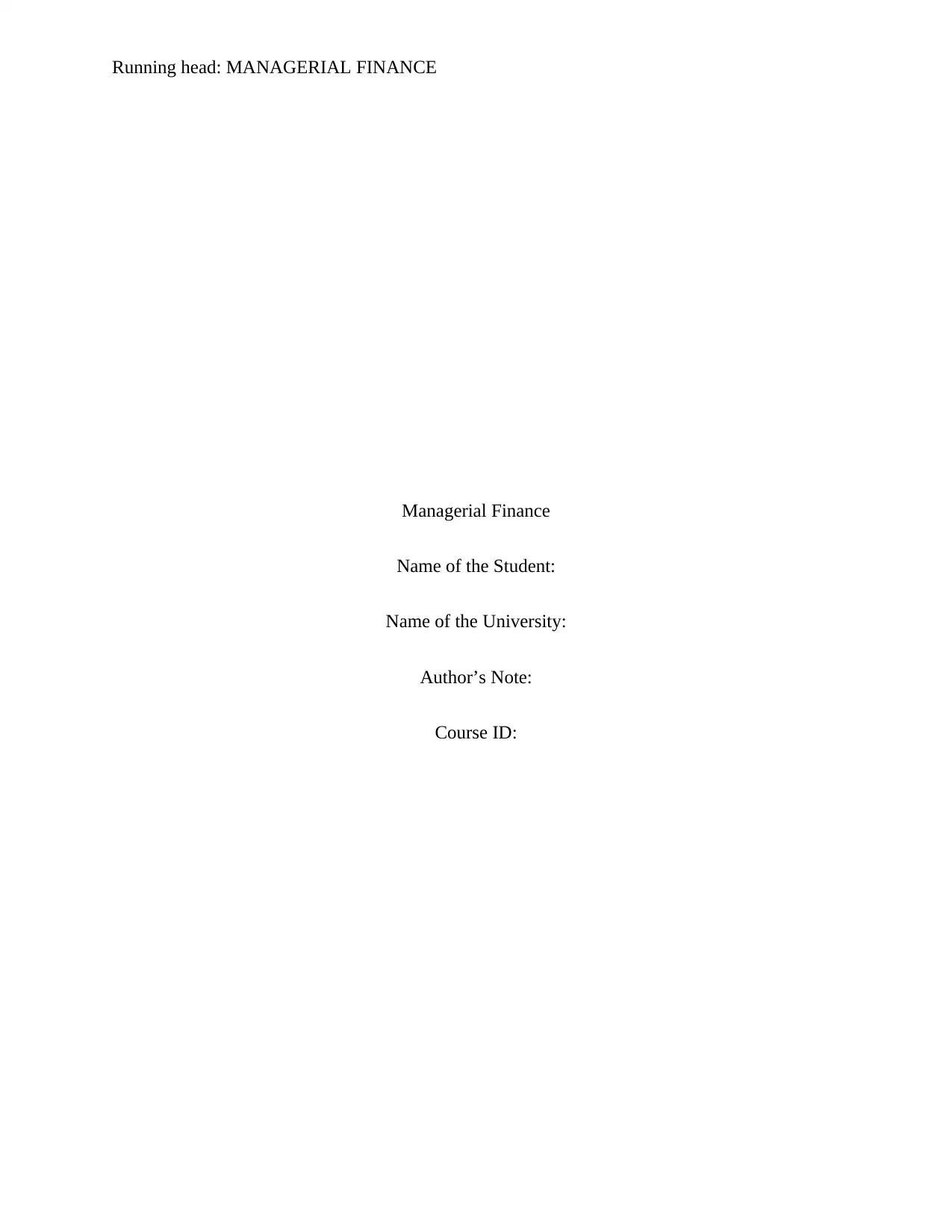
Running head: MANAGERIAL FINANCE
Managerial Finance
Name of the Student:
Name of the University:
Author’s Note:
Course ID:
Managerial Finance
Name of the Student:
Name of the University:
Author’s Note:
Course ID:
Paraphrase This Document
Need a fresh take? Get an instant paraphrase of this document with our AI Paraphraser
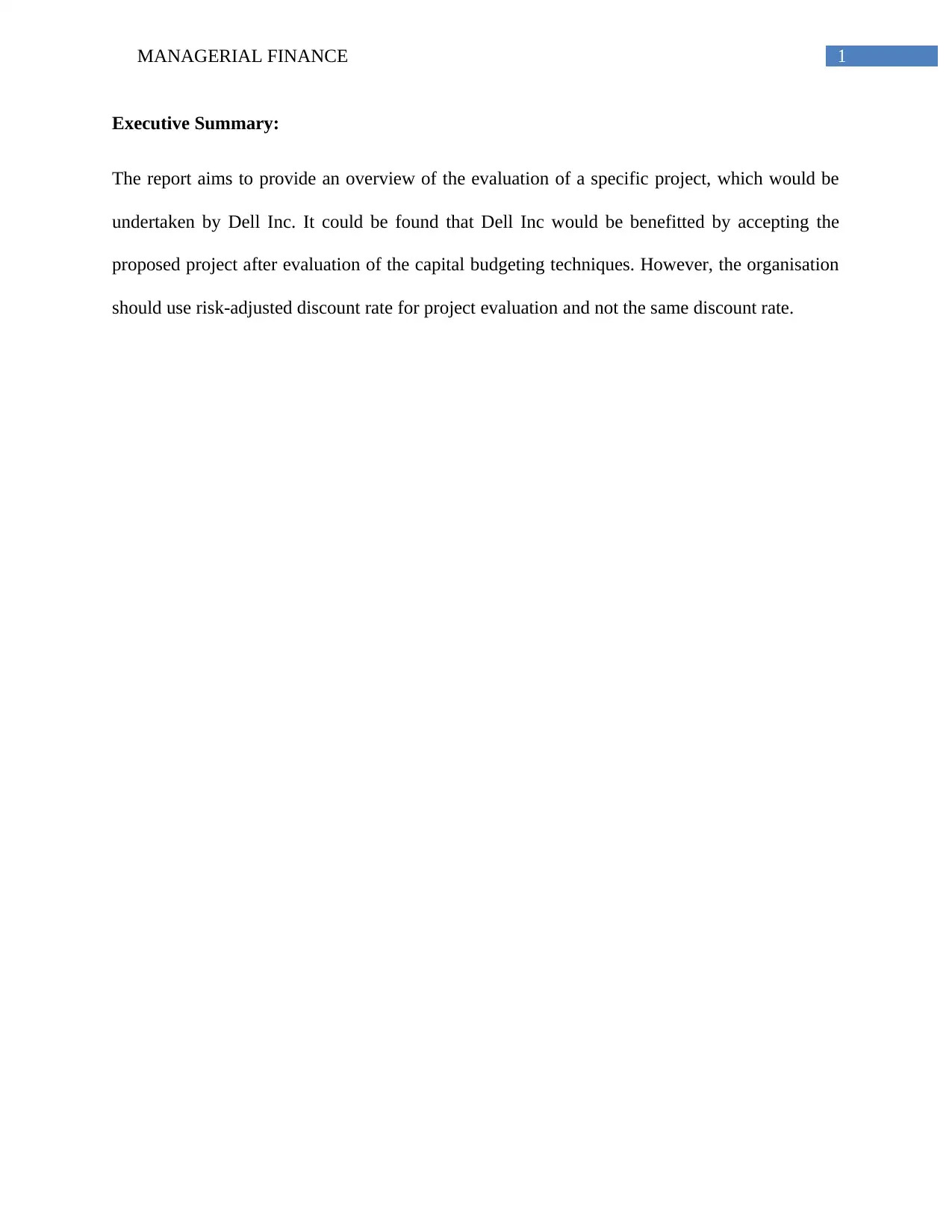
1MANAGERIAL FINANCE
Executive Summary:
The report aims to provide an overview of the evaluation of a specific project, which would be
undertaken by Dell Inc. It could be found that Dell Inc would be benefitted by accepting the
proposed project after evaluation of the capital budgeting techniques. However, the organisation
should use risk-adjusted discount rate for project evaluation and not the same discount rate.
Executive Summary:
The report aims to provide an overview of the evaluation of a specific project, which would be
undertaken by Dell Inc. It could be found that Dell Inc would be benefitted by accepting the
proposed project after evaluation of the capital budgeting techniques. However, the organisation
should use risk-adjusted discount rate for project evaluation and not the same discount rate.

2MANAGERIAL FINANCE
Table of Contents
Introduction:....................................................................................................................................3
Question 1:.......................................................................................................................................3
Requirement a:.............................................................................................................................3
Requirement b:.............................................................................................................................4
Requirement c:.............................................................................................................................4
Requirement d:.............................................................................................................................5
Requirement e:.............................................................................................................................5
Requirement f:.............................................................................................................................5
Requirement g:.............................................................................................................................6
Question 2:.......................................................................................................................................6
Requirement a:.............................................................................................................................6
Requirement b:.............................................................................................................................7
Conclusion and recommendations:..................................................................................................7
References:......................................................................................................................................8
Appendix:........................................................................................................................................9
Table of Contents
Introduction:....................................................................................................................................3
Question 1:.......................................................................................................................................3
Requirement a:.............................................................................................................................3
Requirement b:.............................................................................................................................4
Requirement c:.............................................................................................................................4
Requirement d:.............................................................................................................................5
Requirement e:.............................................................................................................................5
Requirement f:.............................................................................................................................5
Requirement g:.............................................................................................................................6
Question 2:.......................................................................................................................................6
Requirement a:.............................................................................................................................6
Requirement b:.............................................................................................................................7
Conclusion and recommendations:..................................................................................................7
References:......................................................................................................................................8
Appendix:........................................................................................................................................9
⊘ This is a preview!⊘
Do you want full access?
Subscribe today to unlock all pages.

Trusted by 1+ million students worldwide
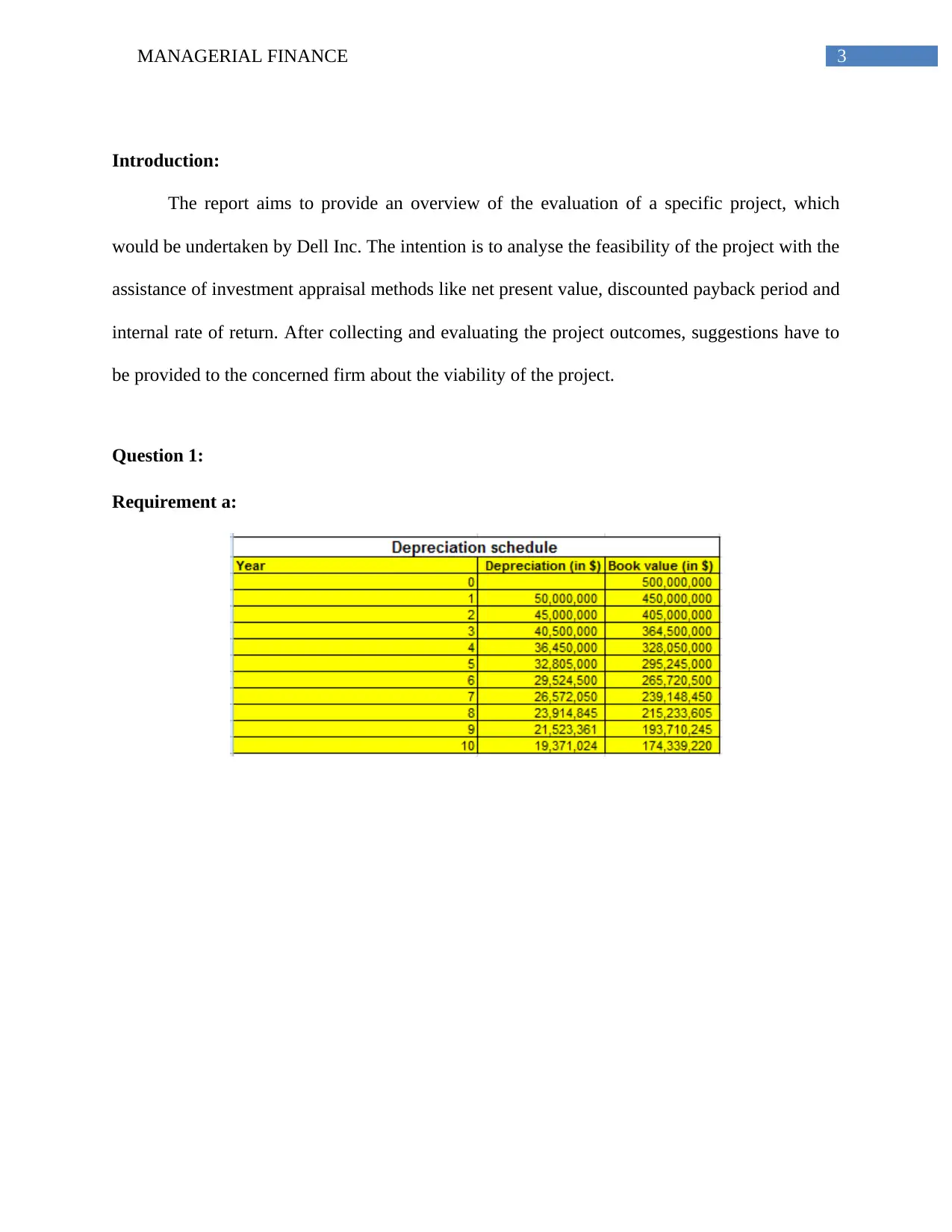
3MANAGERIAL FINANCE
Introduction:
The report aims to provide an overview of the evaluation of a specific project, which
would be undertaken by Dell Inc. The intention is to analyse the feasibility of the project with the
assistance of investment appraisal methods like net present value, discounted payback period and
internal rate of return. After collecting and evaluating the project outcomes, suggestions have to
be provided to the concerned firm about the viability of the project.
Question 1:
Requirement a:
Introduction:
The report aims to provide an overview of the evaluation of a specific project, which
would be undertaken by Dell Inc. The intention is to analyse the feasibility of the project with the
assistance of investment appraisal methods like net present value, discounted payback period and
internal rate of return. After collecting and evaluating the project outcomes, suggestions have to
be provided to the concerned firm about the viability of the project.
Question 1:
Requirement a:
Paraphrase This Document
Need a fresh take? Get an instant paraphrase of this document with our AI Paraphraser
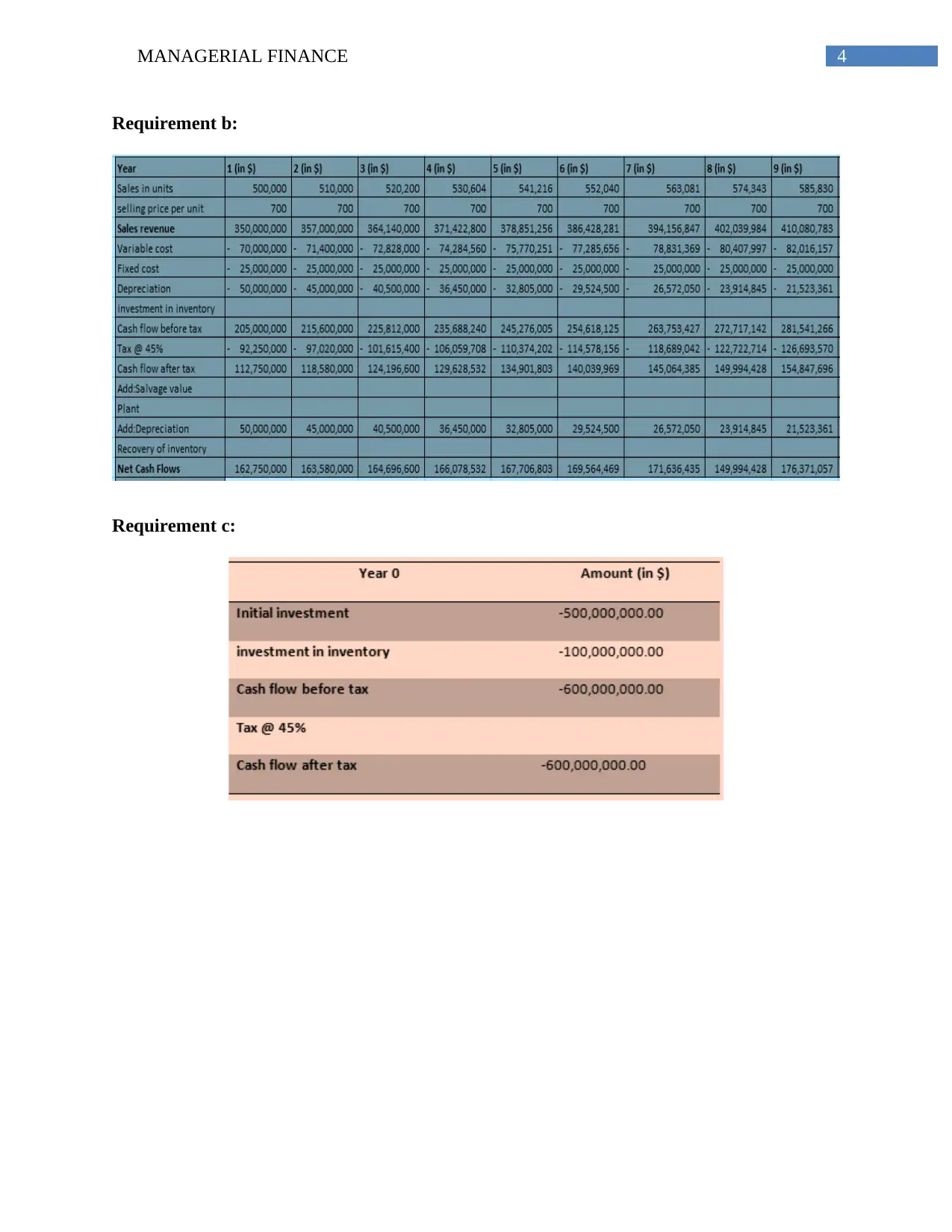
4MANAGERIAL FINANCE
Requirement b:
Requirement c:
Requirement b:
Requirement c:
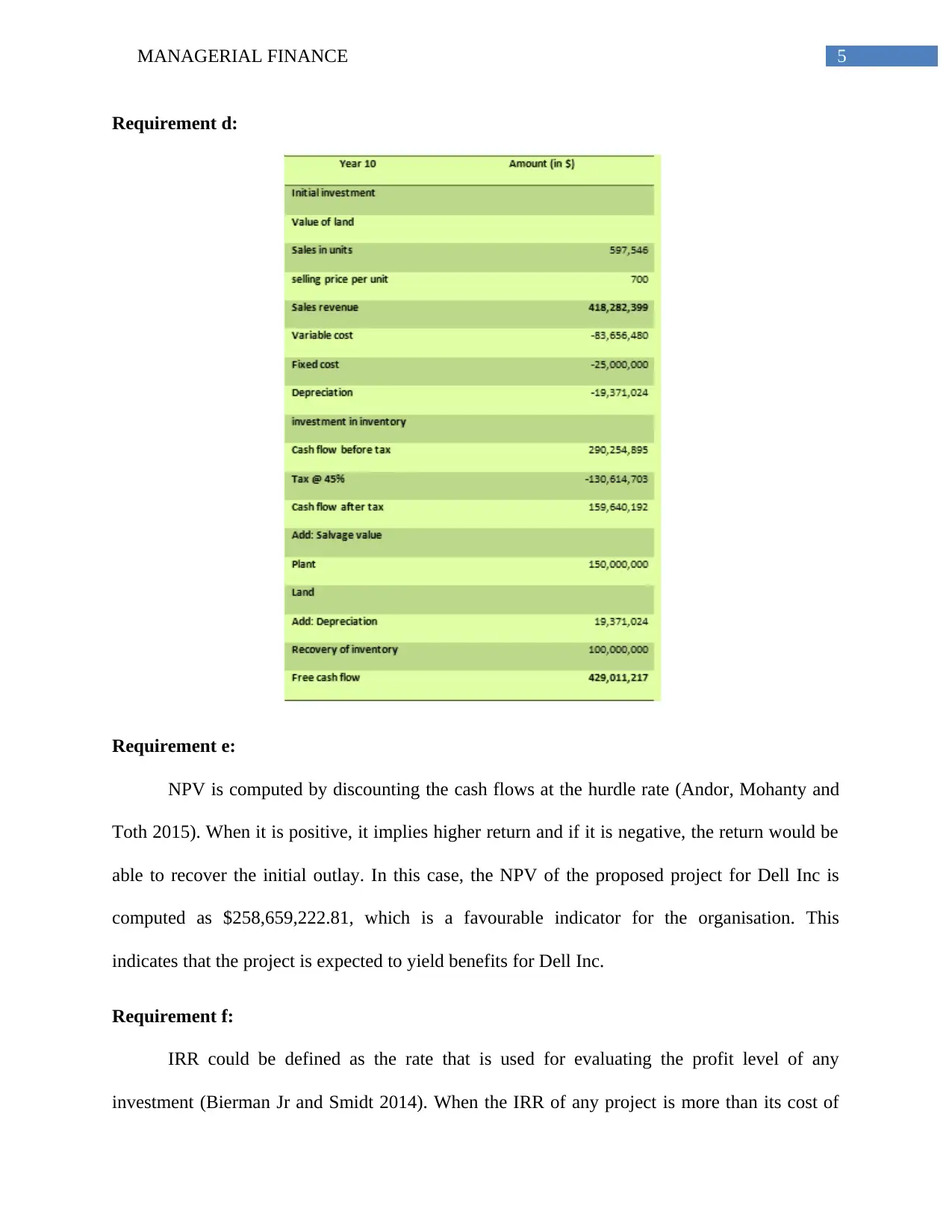
5MANAGERIAL FINANCE
Requirement d:
Requirement e:
NPV is computed by discounting the cash flows at the hurdle rate (Andor, Mohanty and
Toth 2015). When it is positive, it implies higher return and if it is negative, the return would be
able to recover the initial outlay. In this case, the NPV of the proposed project for Dell Inc is
computed as $258,659,222.81, which is a favourable indicator for the organisation. This
indicates that the project is expected to yield benefits for Dell Inc.
Requirement f:
IRR could be defined as the rate that is used for evaluating the profit level of any
investment (Bierman Jr and Smidt 2014). When the IRR of any project is more than its cost of
Requirement d:
Requirement e:
NPV is computed by discounting the cash flows at the hurdle rate (Andor, Mohanty and
Toth 2015). When it is positive, it implies higher return and if it is negative, the return would be
able to recover the initial outlay. In this case, the NPV of the proposed project for Dell Inc is
computed as $258,659,222.81, which is a favourable indicator for the organisation. This
indicates that the project is expected to yield benefits for Dell Inc.
Requirement f:
IRR could be defined as the rate that is used for evaluating the profit level of any
investment (Bierman Jr and Smidt 2014). When the IRR of any project is more than its cost of
⊘ This is a preview!⊘
Do you want full access?
Subscribe today to unlock all pages.

Trusted by 1+ million students worldwide
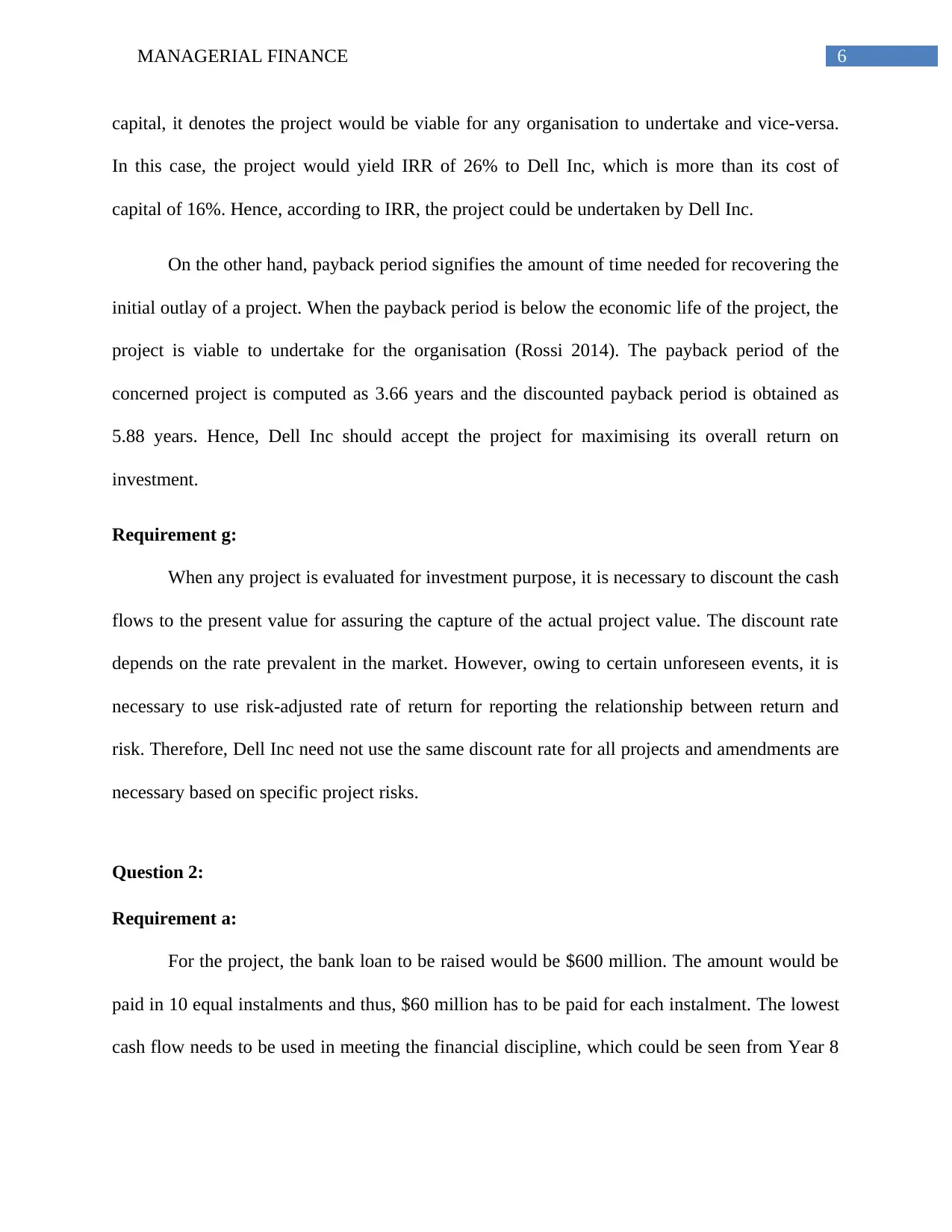
6MANAGERIAL FINANCE
capital, it denotes the project would be viable for any organisation to undertake and vice-versa.
In this case, the project would yield IRR of 26% to Dell Inc, which is more than its cost of
capital of 16%. Hence, according to IRR, the project could be undertaken by Dell Inc.
On the other hand, payback period signifies the amount of time needed for recovering the
initial outlay of a project. When the payback period is below the economic life of the project, the
project is viable to undertake for the organisation (Rossi 2014). The payback period of the
concerned project is computed as 3.66 years and the discounted payback period is obtained as
5.88 years. Hence, Dell Inc should accept the project for maximising its overall return on
investment.
Requirement g:
When any project is evaluated for investment purpose, it is necessary to discount the cash
flows to the present value for assuring the capture of the actual project value. The discount rate
depends on the rate prevalent in the market. However, owing to certain unforeseen events, it is
necessary to use risk-adjusted rate of return for reporting the relationship between return and
risk. Therefore, Dell Inc need not use the same discount rate for all projects and amendments are
necessary based on specific project risks.
Question 2:
Requirement a:
For the project, the bank loan to be raised would be $600 million. The amount would be
paid in 10 equal instalments and thus, $60 million has to be paid for each instalment. The lowest
cash flow needs to be used in meeting the financial discipline, which could be seen from Year 8
capital, it denotes the project would be viable for any organisation to undertake and vice-versa.
In this case, the project would yield IRR of 26% to Dell Inc, which is more than its cost of
capital of 16%. Hence, according to IRR, the project could be undertaken by Dell Inc.
On the other hand, payback period signifies the amount of time needed for recovering the
initial outlay of a project. When the payback period is below the economic life of the project, the
project is viable to undertake for the organisation (Rossi 2014). The payback period of the
concerned project is computed as 3.66 years and the discounted payback period is obtained as
5.88 years. Hence, Dell Inc should accept the project for maximising its overall return on
investment.
Requirement g:
When any project is evaluated for investment purpose, it is necessary to discount the cash
flows to the present value for assuring the capture of the actual project value. The discount rate
depends on the rate prevalent in the market. However, owing to certain unforeseen events, it is
necessary to use risk-adjusted rate of return for reporting the relationship between return and
risk. Therefore, Dell Inc need not use the same discount rate for all projects and amendments are
necessary based on specific project risks.
Question 2:
Requirement a:
For the project, the bank loan to be raised would be $600 million. The amount would be
paid in 10 equal instalments and thus, $60 million has to be paid for each instalment. The lowest
cash flow needs to be used in meeting the financial discipline, which could be seen from Year 8
Paraphrase This Document
Need a fresh take? Get an instant paraphrase of this document with our AI Paraphraser
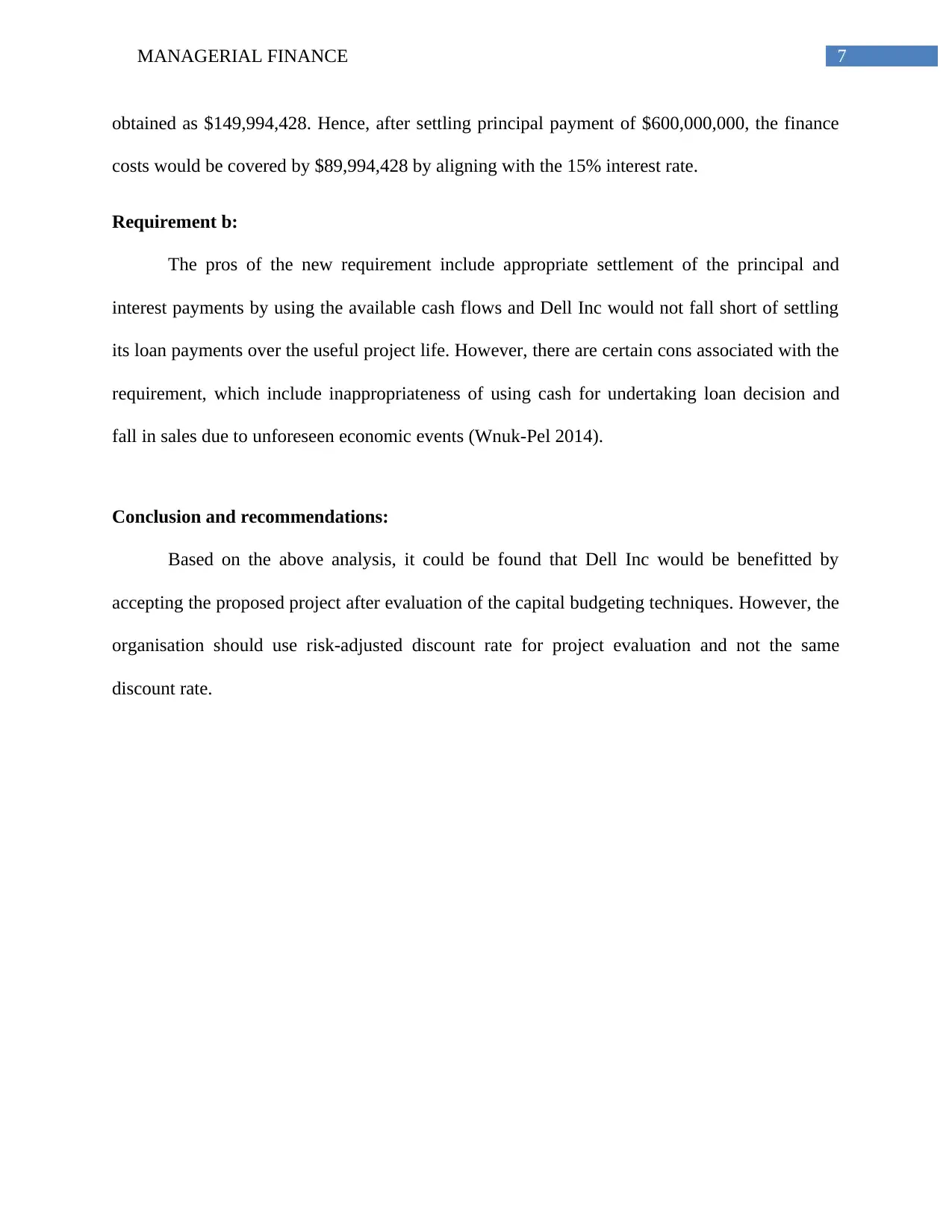
7MANAGERIAL FINANCE
obtained as $149,994,428. Hence, after settling principal payment of $600,000,000, the finance
costs would be covered by $89,994,428 by aligning with the 15% interest rate.
Requirement b:
The pros of the new requirement include appropriate settlement of the principal and
interest payments by using the available cash flows and Dell Inc would not fall short of settling
its loan payments over the useful project life. However, there are certain cons associated with the
requirement, which include inappropriateness of using cash for undertaking loan decision and
fall in sales due to unforeseen economic events (Wnuk-Pel 2014).
Conclusion and recommendations:
Based on the above analysis, it could be found that Dell Inc would be benefitted by
accepting the proposed project after evaluation of the capital budgeting techniques. However, the
organisation should use risk-adjusted discount rate for project evaluation and not the same
discount rate.
obtained as $149,994,428. Hence, after settling principal payment of $600,000,000, the finance
costs would be covered by $89,994,428 by aligning with the 15% interest rate.
Requirement b:
The pros of the new requirement include appropriate settlement of the principal and
interest payments by using the available cash flows and Dell Inc would not fall short of settling
its loan payments over the useful project life. However, there are certain cons associated with the
requirement, which include inappropriateness of using cash for undertaking loan decision and
fall in sales due to unforeseen economic events (Wnuk-Pel 2014).
Conclusion and recommendations:
Based on the above analysis, it could be found that Dell Inc would be benefitted by
accepting the proposed project after evaluation of the capital budgeting techniques. However, the
organisation should use risk-adjusted discount rate for project evaluation and not the same
discount rate.
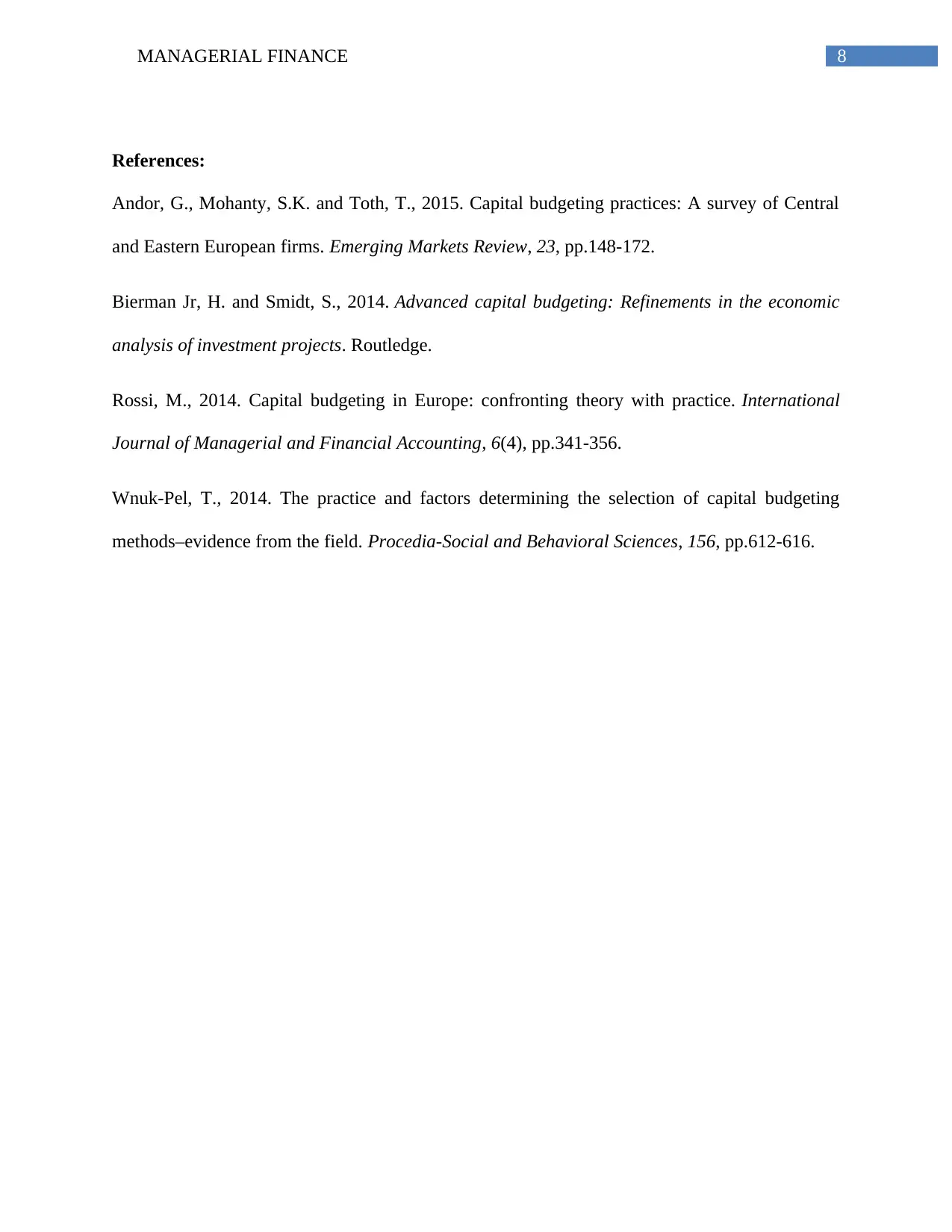
8MANAGERIAL FINANCE
References:
Andor, G., Mohanty, S.K. and Toth, T., 2015. Capital budgeting practices: A survey of Central
and Eastern European firms. Emerging Markets Review, 23, pp.148-172.
Bierman Jr, H. and Smidt, S., 2014. Advanced capital budgeting: Refinements in the economic
analysis of investment projects. Routledge.
Rossi, M., 2014. Capital budgeting in Europe: confronting theory with practice. International
Journal of Managerial and Financial Accounting, 6(4), pp.341-356.
Wnuk-Pel, T., 2014. The practice and factors determining the selection of capital budgeting
methods–evidence from the field. Procedia-Social and Behavioral Sciences, 156, pp.612-616.
References:
Andor, G., Mohanty, S.K. and Toth, T., 2015. Capital budgeting practices: A survey of Central
and Eastern European firms. Emerging Markets Review, 23, pp.148-172.
Bierman Jr, H. and Smidt, S., 2014. Advanced capital budgeting: Refinements in the economic
analysis of investment projects. Routledge.
Rossi, M., 2014. Capital budgeting in Europe: confronting theory with practice. International
Journal of Managerial and Financial Accounting, 6(4), pp.341-356.
Wnuk-Pel, T., 2014. The practice and factors determining the selection of capital budgeting
methods–evidence from the field. Procedia-Social and Behavioral Sciences, 156, pp.612-616.
⊘ This is a preview!⊘
Do you want full access?
Subscribe today to unlock all pages.

Trusted by 1+ million students worldwide
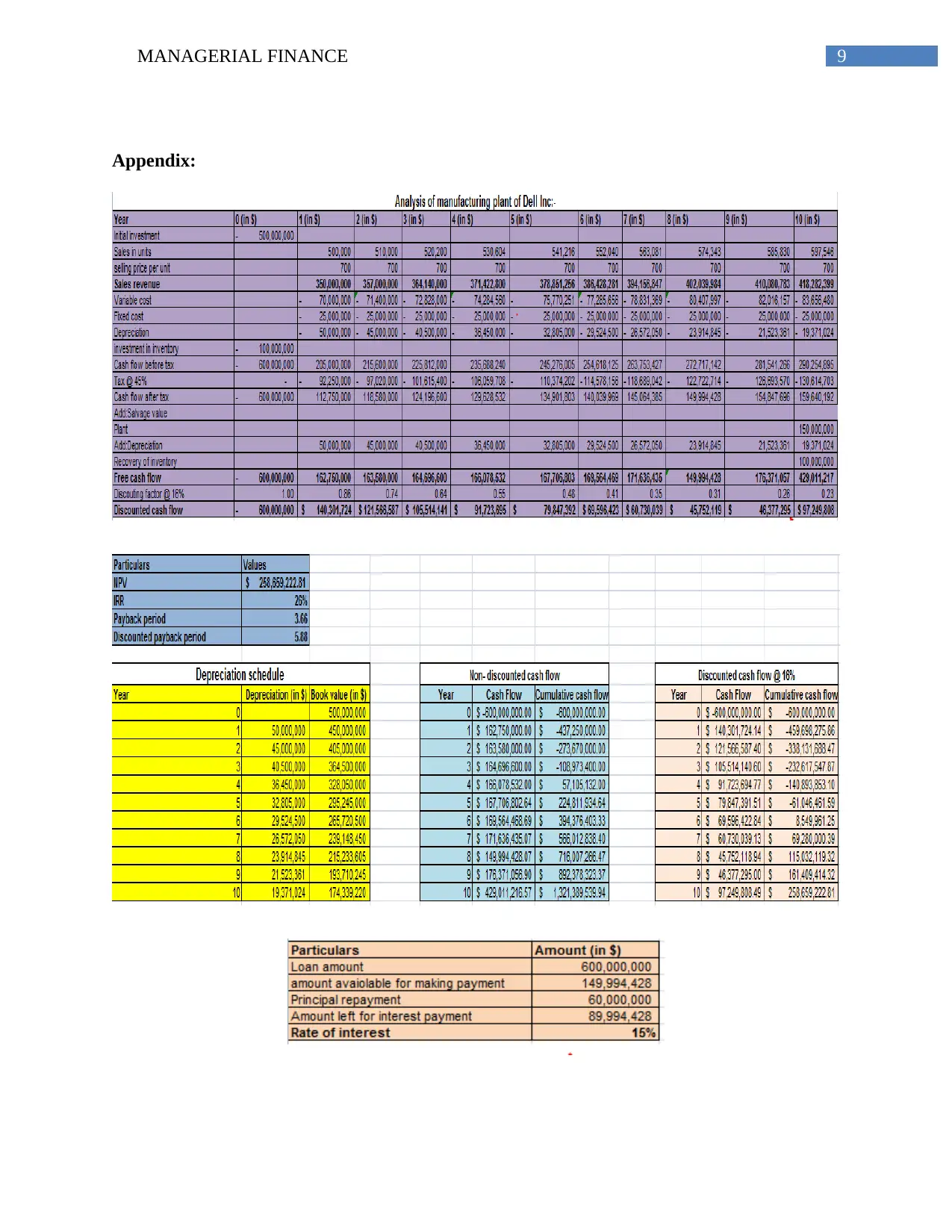
9MANAGERIAL FINANCE
Appendix:
Appendix:
1 out of 10
Related Documents
Your All-in-One AI-Powered Toolkit for Academic Success.
+13062052269
info@desklib.com
Available 24*7 on WhatsApp / Email
![[object Object]](/_next/static/media/star-bottom.7253800d.svg)
Unlock your academic potential
Copyright © 2020–2025 A2Z Services. All Rights Reserved. Developed and managed by ZUCOL.




